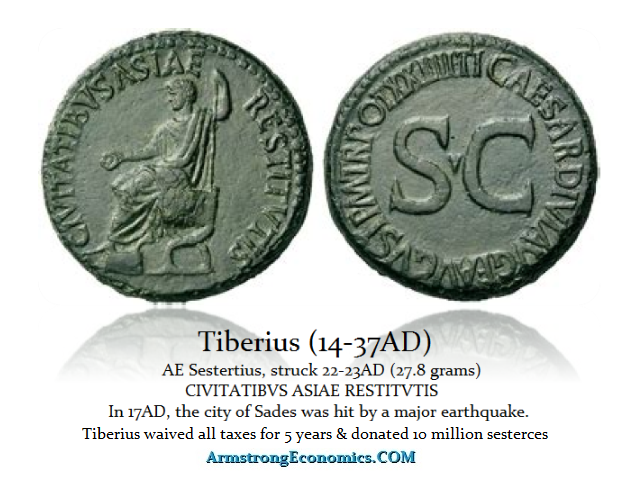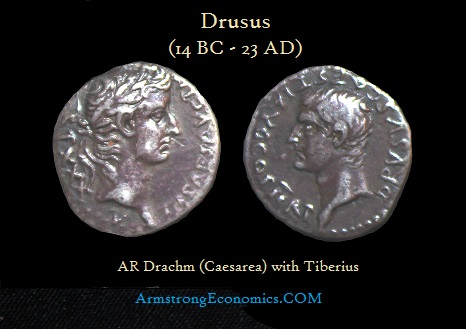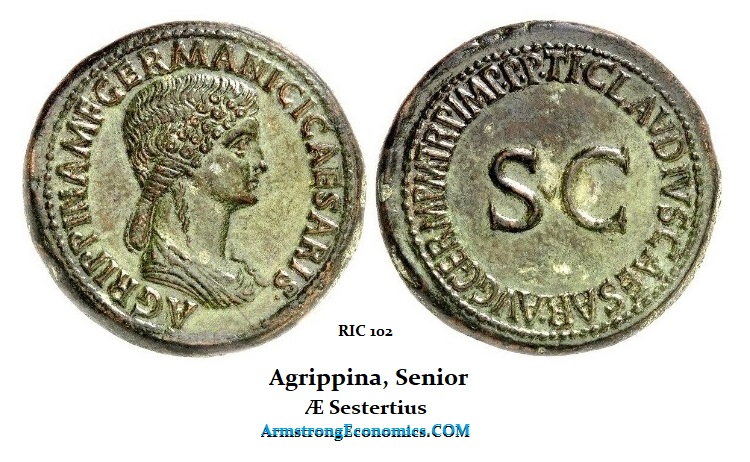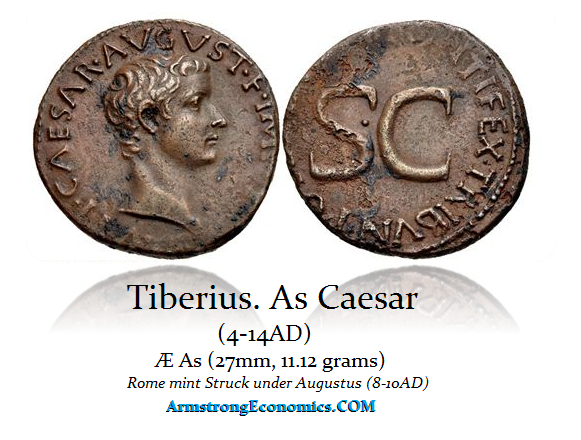Tiberius (14-37AD) Silver Denarius – the Tribute Penny
 The Financial Panic of 33AD provides one of the few detailed accounts of events recorded by the ancient historian Tacitus (56–117AD) whose primary focus appears to be moneylending. Of course, Tacitus did not personally experience the event of being born well after that event. Tiberius (14-37AD) ruled the Roman Empire and was notoriously frugal in his expenditures. He was so frugal, he issued very few coins and they tended to be void of any real variety.
The Financial Panic of 33AD provides one of the few detailed accounts of events recorded by the ancient historian Tacitus (56–117AD) whose primary focus appears to be moneylending. Of course, Tacitus did not personally experience the event of being born well after that event. Tiberius (14-37AD) ruled the Roman Empire and was notoriously frugal in his expenditures. He was so frugal, he issued very few coins and they tended to be void of any real variety.
 Consequently, Tiberius never raised taxes during his reign and in fact lowered Roman taxes when Cappadocia became a province (located in modern Turkey). Tiberius’ frugality also allowed him to be liberal in helping the provinces when a massive earthquake destroyed many of the famous cities of Asia. Nonetheless, Tiberius seems to have detested politics and he withdrew from Rome to live on Capri. Tiberius was never again to return to the city of Rome.
Consequently, Tiberius never raised taxes during his reign and in fact lowered Roman taxes when Cappadocia became a province (located in modern Turkey). Tiberius’ frugality also allowed him to be liberal in helping the provinces when a massive earthquake destroyed many of the famous cities of Asia. Nonetheless, Tiberius seems to have detested politics and he withdrew from Rome to live on Capri. Tiberius was never again to return to the city of Rome.
The political intrigue of the era appears to surround the Prefect or head of the Praetorian Guard who had designs of being the heir to the throne. According to Tacitus, Sejanus’s first subversive act was the seduction of Tiberius’s daughter-in-law, Livilla, who at the time married Drusus, Tiberius’s son. Drusus, it seems, resented Sejanus’s influence over his father so Sejanus, in conjunction with Livilla, poisoned him in 23AD.
Agrippina was the wife of Germanicus and the second granddaughter of Emperor Augustus. She was the sister-in-law, stepdaughter, and daughter-in-law of Emperor Tiberius, mother of Emperor Caligula, sister-in-law and cousin of Emperor Claudius, and maternal grandmother of Emperor Nero. Her heirs would have been logical heirs to the throne that blocked Sejanus who appears to have orchestrated a series of attacks on Agrippina’s friends, mostly played out in the courts in the guise of charges of treason (maiestas).
Then, in 25AD, Sejanus asked Tiberius for permission to marry Livilla, Drusus’s widow. Tiberius refused. Tiberius perhaps began to suspect Sejanus of intrigue. The following year, when the aging emperor withdrew from Rome to live on the isle of Capri, from which Tiberius was never to return to the city of Rome, the tables turned.
Sejanus was ruling Rome guarding his power to access the emperor. With Tiberius absent, Sejanus vented his full fury against Agrippina’s family, whose demise he had been plotting for some time to clear the way to the throne. In rapid succession, Agrippina and her eldest son, Nero Caesar, and eventually, also Drusus Caesar, who had been involved in his brother’s downfall, were arrested, convicted, and imprisoned. Then by 31AD, Sejanus had reached the pinnacle of his power and was effectively emperor himself. The contemporary sources paint the typical picture of senators lining up to pay respects to a man they considered their social inferior but who held the reign of power.
Tiberius seems to have been far from the fool. He rejected Sejanus’s initial proposal to marry Livilla in 25AD, and then cleverly appeared to have withdrawn his objections in 30AD. Sejanus was betrothed to Livilla’s daughter (Tiberius’ granddaughter) instead. The Prefect’s family connection to the Imperial house was now imminent. Then in 31AD, Sejanus held the consulship with the emperor as his colleague, an honor Tiberius reserved only for heirs to the throne. This further made Sejanus assured he would be emperor. When Sejanus surrendered the consulship early in the year since this was an appointment for one-year terms, he was granted a share of the emperor’s proconsular power. Then on October 18th, 31AD, Sejanus was summoned to a meeting of the Senate. Most likely, Sejanus assumed he would have been made co-emperor sharing in the tribunician power. Yet Tiberius may have set the stage to lull him into complacency. Tiberius sent a letter to the Senate from Capri initially praising Sejanus quite extensively, and then suddenly denounced him as a traitor and demanded his arrest.
The political intrigue of 31AD set the stage for the economic meltdown. Sheer chaos ensued. Senators long allied with Sejanus headed for the exits, the others were confused — was this a test of their loyalty? What did the emperor want them to do? Yet the Praetorian Guard, the very troops formerly under Sejanus’s command, had been just secretly transferred to the command of Q. Sutorius Macro. They rushed in and arrested Sejanus, conveyed him to prison, and shortly afterward executed him summarily. A witch-hunt followed. Sejanus’s family was arrested and executed. Livilla perished for her role in poisoning Tiberius’s son Drusus. Any of the followers and friends of Sejanus were denounced and imprisoned, or tried and executed; some committed suicide. Their corruption in securing land in Rome was suddenly exposed. All around the city, grim scenes were played out, and as late as 33AD a general massacre of all those still in custody took place.
The corruption had engulfed Rome. Tiberius resorted to the charge of treason (maiestas) clean house and removing his enemies. Since his working relationship with the Senators was not a good one, repression was a convenient method for dealing with them. Dozens of Senators and equities are on record as having been prosecuted. It was a precedent followed in later years by emperors more tyrannical still than Tiberius had ever been.
Tacitus’ portrayal of Tiberius is one of vengeance. The historian Suetonius records that Tiberius became paranoid, and spent a great deal of time brooding over the death of his son. However, the prominent ancient historian Edward Togo Salmon noted in his work, A history of the Roman world from 30 BC to AD 138:
“In the whole twenty two years of Tiberius’ reign, not more than fifty-two persons were accused of treason, of whom almost half escaped conviction, while the four innocent people to be condemned fell victims to the excessive zeal of the Senate, not to the Emperor’s tyranny”.
Nevertheless, Tacitus provides a detailed account of the Financial Panic of 33AD which appears to be the culmination of the economic collapse and how Tiberius back then engaged in what we call today – monetary easing to solve the financial crisis
The treason trials set off a series of prosecutions that were launched against the corrupt wealthy supporters of Sejanus using laws that were nearly 100 years old and had not been enforced before this period. Once a law is written, man inevitably seems to find a way to apply it for entirely different reasons that justified its creation. These laws targeted moneylending and land in Italy, which had been the target of speculation under the corruption of Sejanus.
The treasury was bulging as the property was seized and resold. This resulted in a tremendous amount of money filling the coffers of the state shrinking the money supply. The confiscation of property of the rich involved with Sejanus was having a devastating impact unleashing a massive contraction in the money supply and setting off DEFLATION.
The Senate in this case sought to protect its own self-interests. The economic distress impacted all the Senators who then suffered a conflict of interest. As a result, they implemented an 18-month stay to allow those impacted by these laws that targeted land ownership and credit to settle their affairs before final judgment.
Limitations were then imposed on credit. It was required that two-thirds of every loan should be invested in Italian land to reduce speculation in the provinces. On top of that, it was decreed that two-thirds of every loan should be paid off. This was massively deleveraging the economy. This created the ancient version of the S&L Crisis of the USA of the 1980s and 1990s which was the failure of 1,043 out of the 3,234 savings and loan associations between 1986 to 1995. That was set in motion by the Democrats changing the laws to get the rich as well as removing the benefits of investing in land. The S&Ls were by a law targeted to real estate so Congress set in motion a panic selling spree that collapsed real estate prices. In both cases, the legislation created a one-way market of all sellers and no buyers without absolute distress prices.
By restricting loans to Italian land and then ordering two-thirds of such debts should be paid off, this too set in motion the collapse of real estate. Loans were now called in to be paid in full and nobody wanted to be associated with this witch-hunt of the rich followers of Sejanus. Debtors were now forced to sell and the market was flooded with real estate collapsing the market prices for everyone. Combine this with the shortage of money, and this turned into such a financial meltdown that its significance was recorded by Tacitus.
 There was a severe shortage of money. It was during the reign of Tiberius that we see a host of tokens being privately produced to compensate for the shortage of coinage. We saw precisely the same response during the Great Depression in the United States during the 1930s. The lack of money in circulation resulted in hundreds of cities issuing their own money just to be able to function.
There was a severe shortage of money. It was during the reign of Tiberius that we see a host of tokens being privately produced to compensate for the shortage of coinage. We saw precisely the same response during the Great Depression in the United States during the 1930s. The lack of money in circulation resulted in hundreds of cities issuing their own money just to be able to function.
 Tiberius also saw the contagion spreading from the Senate’s corruption that crippled the banking system. The firm Seuthes and Son, of Alexandria, was a firm facing difficulties because of the loss of three richly laden ships in a Red Sea storm, followed by a fall in the value of ostrich feathers and ivory. Nearly at the same time, there was the house of Malchus and Co. of Tyre with branches at Antioch and Ephesus. They suddenly became bankrupt as a result of a strike among their Phoenician workmen and the embezzlement of a freedman manager. These two failures also affected the Roman banking house, Quintus Maximus and Lucious Vibo operating in the Roman forum.
Tiberius also saw the contagion spreading from the Senate’s corruption that crippled the banking system. The firm Seuthes and Son, of Alexandria, was a firm facing difficulties because of the loss of three richly laden ships in a Red Sea storm, followed by a fall in the value of ostrich feathers and ivory. Nearly at the same time, there was the house of Malchus and Co. of Tyre with branches at Antioch and Ephesus. They suddenly became bankrupt as a result of a strike among their Phoenician workmen and the embezzlement of a freedman manager. These two failures also affected the Roman banking house, Quintus Maximus and Lucious Vibo operating in the Roman forum.
 These events set in motion bank runs, which then impacted another major Roman banking house of the Brothers Pittius. The Wall Street of the day in the Forum was the Via Sacra which erupted in panic as merchants were now impacted by the collapse in banking and money supply. There was then also a rebellion among the people of Northern Gaul, so now the emerging markets went into crisis as well. Money was contracting as nobody would lend and hoarding soared.
These events set in motion bank runs, which then impacted another major Roman banking house of the Brothers Pittius. The Wall Street of the day in the Forum was the Via Sacra which erupted in panic as merchants were now impacted by the collapse in banking and money supply. There was then also a rebellion among the people of Northern Gaul, so now the emerging markets went into crisis as well. Money was contracting as nobody would lend and hoarding soared.
When Publius Spencer, a wealthy nobleman, requested 30 million sesterces from his banker Balbus Ollius, the firm was unable to fulfill his request and closed its doors. Over the next few days, prominent banks in Corinth, Carthage, Lyons, and Byzantium announced they had to “rearrange their accounts,” i.e. they had failed. This led to a banking panic and the closure of several banks along the Via Sacra in Rome.
As the crisis spread, banks began calling in their loans on everyone trying to raise capital. When debtors could not meet the demands of their creditors, they were forced to sell their homes and possessions, with money unavailable even at the legal limit of 12% interest. The prices of real estate and other goods just completely collapsed in a downward spiral of DEFLATION. A full-scale panic was sweeping the entire Empire.
The Financial Panic of 33AD became so severe it forced Emperor Tiberius to implement what we would call quantitative easing. Within a matter of days of arresting Sejanus, the contraction began. Eventually, the decrees which had precipitated the problem were suspended. 100 million sesterces were to be taken from the imperial treasury and distributed among reliable bankers, to be loaned to the neediest debtors. A loaf of bread sold for half a sestertius and soldiers earned around 1000 sesterces annually. So this was about an equivalent of around $2 billion in modern terms considering the lower population at that time.
The loans were to be interest-free. No interest was to be collected for three years. Security was to be offered at the double value of the real property. This enabled many people to avoid selling their estates at distressed prices, arresting the contraction in prices and ensuring that the lack of liquidity would be addressed. Many banks just never survived.









